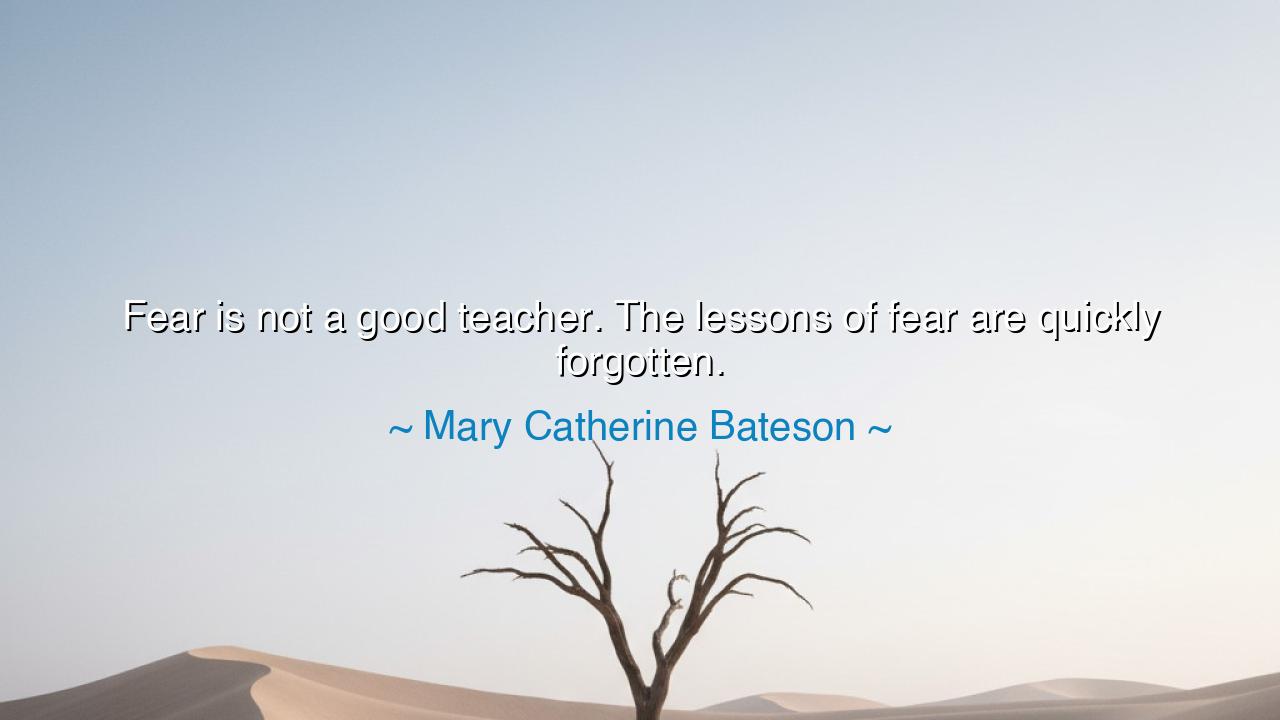
Fear is not a good teacher. The lessons of fear are quickly






The words of Mary Catherine Bateson—“Fear is not a good teacher. The lessons of fear are quickly forgotten”—speak with a clarity that pierces the heart like an arrow. They remind us that though fear may strike quickly, though it may bend the will for a time, it does not root itself in the soul. Its lessons are shallow, fading as soon as the shadow passes. For what is learned in trembling is not truly learned at all. Only that which is embraced with understanding and conviction remains. Fear may silence, fear may restrain, but it cannot transform.
The origin of this truth lies in the experience of countless generations. Parents, rulers, and teachers have often turned to fear as a tool, believing that punishment or threat could shape obedience. Yet time reveals the futility of such methods. The child who obeys out of dread will rebel when the danger is gone. The people who submit to a tyrant will rise when his hand is weakened. The soldier who fights only to avoid punishment will flee when the chance presents itself. Fear is a whip—it drives forward for a moment, but it leaves no enduring strength.
History provides us with vivid examples. Consider the reign of Robespierre during the French Revolution. Through terror, he sought to enforce virtue, filling the streets with executions and silencing all dissent. For a time, the people obeyed, paralyzed by fear. But when his own power wavered, the lessons of fear dissolved. Those who once bowed before him turned against him, and he himself fell to the very blade he had commanded. The terror did not create loyalty or justice—it created only temporary compliance, forgotten as soon as the fear lifted.
By contrast, look to Mahatma Gandhi, who taught through courage and nonviolence. He did not demand obedience by threats, but inspired it through moral strength. His followers learned not through trembling but through conviction. And because they were not driven by fear, but by a vision of justice, their lessons endured. Even after Gandhi was gone, his teachings continued to shape nations. Fear fades; inspiration remains. This is the eternal difference.
The emotional power of Bateson’s words lies in their quiet wisdom. Fear is intense, but it is fleeting. Its fire burns hot but dies quickly, leaving behind only ash. True teaching requires patience, compassion, and the stirring of the heart. The student, the citizen, the child—these are not clay to be struck with force, but gardens to be tended with care. To sow fear is to reap rebellion or forgetfulness; to sow understanding is to reap wisdom that endures across generations.
There is also something heroic in this teaching. For it calls upon us to resist the easy path. Fear is simple: it demands no creativity, no compassion, only force. But to inspire requires courage, empathy, and vision. Leaders who choose inspiration over intimidation, parents who choose guidance over punishment, teachers who choose encouragement over threat—these are the true heroes, for they build not only obedience but character.
The lesson for us is plain: if we wish to shape lasting change, we must abandon fear as our tool. Whether in families, schools, or nations, we must turn instead to respect, understanding, and hope. Let us ask ourselves: do we wish for those we guide to tremble for a moment, or to walk with strength for a lifetime? Fear fades; love endures. Fear silences; wisdom sings. Fear enslaves; inspiration frees.
Thus, Bateson’s words endure as a beacon: fear is not a good teacher. Its lessons vanish like mist at sunrise. But the lessons of compassion, trust, and vision endure like mountains. Whoever seeks to guide others must therefore put aside the whip of fear and take up the lamp of wisdom, lighting the path not with threats, but with truth that shines even in the darkest hour.






AAdministratorAdministrator
Welcome, honored guests. Please leave a comment, we will respond soon